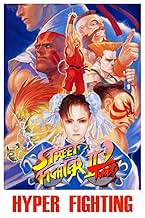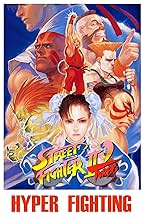Still Street Fighter II. Same characters. Same stages (minor changes to colors here and there). Same attract screen. Same final four battles. New colors for the logo. New alternate color for the characters (most are a drastic improvement over CE). But that's okay, I never got hooked on CE like I did with World Warriors so I was ready for another video game obsession for awhile.
With SF2T Capcom intended to answer the bootleg chips that arcades had implemented. Bootleg "accelerated" chips that altered the game in a number of ways -- aerial execution of ground based moves, crawling fireballs, full-screen dragon punch arcs, no charge time etc, etc, etc.
Thus, on the game play level Capcom's official game, Hyper Fighting, bumped up the speed and allowed a few formerly ground-only attacks to take to the air: Ken/Ryu's hurricane kick (which I overuse and abuse to this day) and Chun-Li's spinning bird kick. Other characters received new ground-based moves that allowed them to attack air-borne opponents more effectively: both E Honda and Blanka now sport a charge move that launches them up at a 45 degree angle. Still, other characters received a different flavor of new abilities -- Dhalsim can teleport, Zangief has a new spinning clothesline which negates low attacks, Chun-Li has an underwhelming fireball.
Unfortunately, many (if not all) of the new moves quite plainly recycle previous animations. Capcom pulled Chun-Li's fireball from one of her fierce punches and recolored a Yoga Fire. Blanka's new rolling attack appears virtually identical to his previous rolling attack with a new direction. Honda's new sumo leaping attack? Assembled from two of his jump attack animations. Dhalsim's teleport uses one of his victory poses. And so on, and so forth.
Despite where the moves came from, they do add a new dimension to the existing arsenal of moves in Street Fighter II. As far as new content, I believe Guile received the least of the pack (not that he needed anything new.) Although Capcom did scale down his flash-kick from a single-hit knockdown to a two-hit knockdown where unless both hits connected Guile would be left vulnerable (thank God.) No longer the turtle-from-hell he used to be.
Ryu and Ken started receiving variations in their moves -- Ryu's hurricane kick leaned towards powerful single-hit knockdowns, while Ken's drifted towards a flurry of weaker multihits more suited for combos. Ken's dragon punch gained a wider arc than his rival, and retained the double-hit quality. Ryu, by contrast, simplified his Dragon Punch down to do more damage in fewer hits.
Other fine tune tweaks exist throughout the entire game from exact range to the priority of individual character moves, but one would have to be a hardcore SF2 player to notice them all without playing Champion Edition and Turbo back to back. At its core, Street Fighter II' Turbo: Hyper Fighting is still Street Fighter II. As I said in the opening paragraph: same game, same characters, same stages, a few new bells and whistles.
Street Fighter II' version 3.0, the upgrade, if you will.





















